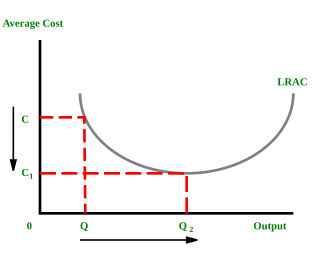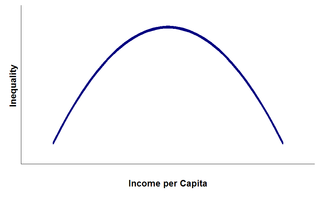
In microeconomics, economies of scale are the cost advantages that enterprises obtain due to their scale of operation, and are typically measured by the amount of output produced per unit of time. A decrease in cost per unit of output enables an increase in scale. At the basis of economies of scale, there may be technical, statistical, organizational or related factors to the degree of market control.

A megacity is a very large city, typically with a population of more than 10 million people. The United Nations Department of Economic and Social Affairs in its 2018 "World Urbanization Prospects" report defines megacities as urban agglomerations with over 10 million inhabitants. A University of Bonn report holds that they are "usually defined as metropolitan areas with a total population of 10 million or more people". Elsewhere in other sources, from five to eight million is considered the minimum threshold, alongside a population density of at least 2,000 per square kilometre. The terms conurbation, metropolis, and metroplex are also applied to the latter.

Urbanization is the population shift from rural to urban areas, the corresponding decrease in the proportion of people living in rural areas, and the ways in which societies adapt to this change. It can also mean population growth in urban areas instead of rural ones. It is predominantly the process by which towns and cities are formed and become larger as more people begin living and working in central areas.

Economic geography is the subfield of human geography that studies economic activity and factors affecting it. It can also be considered a subfield or method in economics. There are four branches of economic geography.

Urban geography is the subdiscipline of geography that derives from a study of cities and urban processes. Urban geographers and urbanists examine various aspects of urban life and the built environment. Scholars, activists, and the public have participated in, studied, and critiqued flows of economic and natural resources, human and non-human bodies, patterns of development and infrastructure, political and institutional activities, governance, decay and renewal, and notions of socio-spatial inclusions, exclusions, and everyday life. Urban geography includes different other fields in geography such as the physical, social, and economic aspects of urban geography. The physical geography of urban environments is essential to understand why a town is placed in a specific area, and how the conditions in the environment play an important role with regards to whether or not the city successfully develops. Social geography examines societal and cultural values, diversity, and other conditions that relate to people in the cities. Economic geography is important to examine the economic and job flow within the urban population. These various aspects involved in studying urban geography are necessary to better understand the layout and planning involved in the development of urban environments worldwide.
Urban economics is broadly the economic study of urban areas; as such, it involves using the tools of economics to analyze urban issues such as crime, education, public transit, housing, and local government finance. More specifically, it is a branch of microeconomics that studies the urban spatial structure and the location of households and firms.

The Kuznets curve expresses a hypothesis advanced by economist Simon Kuznets in the 1950s and 1960s. According to this hypothesis, as an economy develops, market forces first increase and then decrease economic inequality. The Kuznets curve appeared to be consistent with experience at the time it was proposed. However, since the 1970s, inequality has risen in the US and other developed countries, which invalidates the hypothesis.

Masahisa Fujita is a Japanese economist who has studied regional science and Urban economics and International Trade, Spatial Economy. He is a professor at Konan University and an adjunct professor at Institute of Economic Research, Kyoto University.
New trade theory (NTT) is a collection of economic models in international trade theory which focuses on the role of increasing returns to scale and network effects, which were originally developed in the late 1970s and early 1980s. The main motivation for the development of NTT was that, contrary to what traditional trade models would suggest, the majority of the world trade takes place between countries that are similar in terms of development, structure, and factor endowments.
Regional economics is a sub-discipline of economics and is often regarded as one of the fields of the social sciences. It addresses the economic aspect of the regional problems that are spatially analyzable so that theoretical or policy implications can be the derived with respect to regions whose geographical scope ranges from local to global areas.
A business cluster is a geographic concentration of interconnected businesses, suppliers, and associated institutions in a particular field. Clusters are considered to increase the productivity with which companies can compete, nationally and globally. Accounting is a part of the business cluster. In urban studies, the term agglomeration is used. Clusters are also important aspects of strategic management.
Spatial inequality refers to the unequal distribution of income and resources across geographical regions. Attributable to local differences in infrastructure, geographical features and economies of agglomeration, such inequality remains central to public policy discussions regarding economic inequality more broadly.

Urbanization in China increased in speed following the initiation of the reform and opening policy. By the end of 2023, China had an urbanization rate of 66.2% and is expected to reach 75-80% by 2035.
Innovation economics is new, and growing field of economic theory and applied/experimental economics that emphasizes innovation and entrepreneurship. It comprises both the application of any type of innovations, especially technological, but not only, into economic use. In classical economics this is the application of customer new technology into economic use; but also it could refer to the field of innovation and experimental economics that refers the new economic science developments that may be considered innovative. In his 1942 book Capitalism, Socialism and Democracy, economist Joseph Schumpeter introduced the notion of an innovation economy. He argued that evolving institutions, entrepreneurs and technological changes were at the heart of economic growth. However, it is only in recent years that "innovation economy," grounded in Schumpeter's ideas, has become a mainstream concept".
Knowledge spillover is an exchange of ideas among individuals. Knowledge spillover is usually replaced by terminations of technology spillover, R&D spillover and/or spillover (economics) when the concept is specific to technology management and innovation economics. In knowledge management economics, knowledge spillovers are non-rival knowledge market costs incurred by a party not agreeing to assume the costs that has a spillover effect of stimulating technological improvements in a neighbor through one's own innovation. Such innovations often come from specialization within an industry.
Cluster theory is a theory of strategy.
Economic globalization is one of the three main dimensions of globalization commonly found in academic literature, with the two others being political globalization and cultural globalization, as well as the general term of globalization. Economic globalization refers to the widespread international movement of goods, capital, services, technology and information. It is the increasing economic integration and interdependence of national, regional, and local economies across the world through an intensification of cross-border movement of goods, services, technologies and capital. Economic globalization primarily comprises the globalization of production, finance, markets, technology, organizational regimes, institutions, corporations, and people.
Thierry Mayer is a French economist and Professor of Economics at Sciences Po. He belongs to the most frequently-cited economists in the field of international trade. In 2006, Mayer and Etienne Wasmer were awarded the Best Young Economist of France Award by Cercle des économistes and Le Monde.
Gianmarco Ireo Paolo Ottaviano is an Italian economist and Professor of Economics at Bocconi University.
John Vernon Henderson is a Canadian-American economist and an academic. He is a Research Affiliate at the International Growth Centre, Director of the Urbanisation in Developing Countries Program, and a School Professor of Economic Geography at the London School of Economics.










